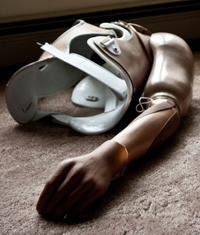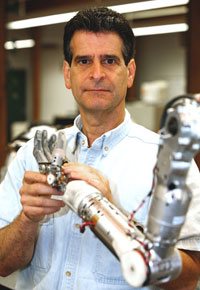JUNE 22, 2008 WAS A GORGEOUS EARLY SUMMER DAY, with partly cloudy skies and 80-degree temperatures.
Taking advantage of the weather, Greg Reynolds, a muscular 24-year-old veteran of Operation Iraqi Freedom, hopped on his yellow Suzuki TL1000R racing bike to spend the morning at Colt State Park in Bristol, R.I., a swath of land on Narragansett Bay some 17 miles south of his house in Dighton, Mass.
The TL1000R is not a motorcycle for the casual rider. Its 996C, 4-stroke engine is capable of 9,500 RPM — or zero to 60 miles per hour in about 3.6 seconds — giving the rider the feeling of being strapped onto the nose of a rocket.
Reynolds was no casual enthusiast. Riding was his salvation, an escape from the nagging sense of rage and discomfort that had followed him home from the desert. Those feelings drove him to maniacal workouts, until he could bench-press almost twice his weight. Hurtling down the highway gave him a sense of control that eluded his civilian life.
At about 1:30 p.m., on his way back home from the beach, a 2004 Chevrolet Impala turned left from the I-95 off-ramp onto Route 136 in Swansea, Mass. What happened next took about three seconds:
One second for him to see the Chevy. One second to lock up both brakes on the Suzuki. One second to steer toward the rear of the car.
 Reynolds almost made it. Great braking, an independent accident investigator later said, slowed the bike from 43 miles per hour to 25 mph at the point of impact — if he’d collided with the Impala at 35 or 40, he would’ve died. As it happened, his bike smashed the Chevy’s rear passenger door and broke through the window.
Reynolds almost made it. Great braking, an independent accident investigator later said, slowed the bike from 43 miles per hour to 25 mph at the point of impact — if he’d collided with the Impala at 35 or 40, he would’ve died. As it happened, his bike smashed the Chevy’s rear passenger door and broke through the window.
The driver of the car, 75-year-old James Viera of Tiverton, Mass., walked away from the scene. Reynolds bore the brunt of the crash. Soon after he reached Rhode Island Hospital in Providence via ambulance, doctors made an alarming suggestion.
“Gather up the family,” they told Reynolds’ mother.
The black hooded sweatshirt used to fit.
It’s early April as Reynolds sits at the dining room table at his mother’s house in Dighton. His weight has rebounded, but the chiseled soldier who returned from Iraq with an Army Commendation Medal with Valor is only a memory.
“I have to rebuild myself into a different person really,” he says, the empty arm of his sweatshirt hanging limply.
The crash mangled Reynolds’ body even more than his bike. He spent nearly six weeks in a coma. He broke neck bones and ribs, sustained a diffuse axonal brain injury, a severed subclavian artery, nerve damage in his right hand and a punctured left knee joint. He needed a ventilator to help him breathe. In the first two weeks after the accident, he received 110 units of blood and blood products. At one point, his kidneys were temporarily shut down. He underwent dialysis for four weeks. Somehow he recovered from it all. Except for one thing.
Reynolds’ arm was so badly damaged that doctors had to remove the arm at the shoulder joint; a devastating injury for anyone, but particularly for Reynolds, who spent 339 days on the ground in Iraq without so much as a scratch. The irony can be suffocating for him still. After all, how does an indestructible soldier go through hell only to be struck down by a 75-year-old driving a Chevy Impala?
It’s early spring, nearly a year since the accident, but he’s quick to cover up with a baggy sweatshirt, explaining that there’s still a part of him that is very self-conscious about his appearance. He especially doesn’t want anyone taking his picture without the hoodie.
As a forequarter amputee, Reynolds must re-learn and re-build himself anew. Like all of the estimated 1.7 million amputees living in the U.S., he has had to deal with something almost no one can imagine: Missing a part of yourself – not in some abstract, emotional sense, but in a very physical, “Oh-my-god-I-don’t-have-an-arm” way.
 “Who would’ve thought, putting on shoes, putting on socks, is really, really hard with one hand,” Reynolds says. “Doing laundry with one hand, trying to cut a steak with one hand, or opening a piece of mail … I could go on for days about how hard it is to live with one hand.”
“Who would’ve thought, putting on shoes, putting on socks, is really, really hard with one hand,” Reynolds says. “Doing laundry with one hand, trying to cut a steak with one hand, or opening a piece of mail … I could go on for days about how hard it is to live with one hand.”
But Reynolds might not have to live with one hand for the rest of his natural life. Thanks to advances in science and engineering, plus a lot of help from the government, advances in prosthetics are moving at a faster pace then they have in the past 500 years. And while the challenges are daunting and the event horizon could be decades away, some day Greg Reynolds might actually be able to live a life as normal as it was the day before his accident.
Progress measured in centuries
Although the use of prosthetic limbs can be traced back to ancient Egypt, the birth of modern prosthetics probably came during the 16th century, according to Christopher Lambert, an associate bioengineering research professor at Worcester Polytechnic Institute.
It was in the early 1500s when Ambroise Paré, a French military doctor, revolutionized amputation procedures and modern prosthetics. Paré, who was also a barber, invented several devices for upper and lower extremities featuring many engineering innovations still in use today, including the mechanical hand, a knee lock control for legs and adjustable harnesses to attach the limb to the body. These advances led to the socket prosthetic, whereby an artificial limb could be attached to a partial limb.
Depending on how you look at it, the fact that Paré’s interface is still widely in use today is either a testament to his genius or an indictment of modern medicine.
Lambert says there are some significant problems with the socket prosthetic, due to its interface with the body. For example, he says, a prosthetic’s cushioned socket protects from chafing, but doesn’t provide any tactile feedback for the user. People with artificial legs often stumble as a result, because they have no feel for the ground beneath their feet. And for people with upper-limb loss, lugging around a heavy prosthetic limb can lead to severe back pain. For someone like Reynolds, who has nothing to attach a limb to, socket prosthetics are even more ineffective.
Upper-limb amputees, Lambert says, face a lose-lose proposition style vs. function.
“You can make an artificial hand that looks realistic, but it’s useless,” he explains. “For most patients, the most useful arm is a hook. That might be articulated, but we’re still going back to ‘Peter Pan.'”
One of the last major advances, the myoelectric arm, was first invented in the early 1960s and is still widely used today. Such devices use electromyographical signals from the muscles to control movements in the prosthetic limb. Reynolds himself uses one, with an artificial shoulder joint. The battery-powered bundle of plastic, metal and wires weighs 7½ pounds. Electrodes over muscles in his back and torso control its functions. It’s a breakthrough technology that would cost a civilian patient about $90,000, according to Luke Richards, Reynolds’ prosthetist at the Jamaica Plain, Mass., Veterans Administration facility.
Why, after 500 years, are amputees still forced to choose a hook over an expensive yet still relatively rudimentary piece of plastic?
 “There’s no doubt that advances are slow and, in some cases, painfully slow,” admits Brad Ruhl, president and CEO of Otto Bock Inc. The company, which makes Reynolds’ new arm, was incorporated after World War I in Germany and has been a market leader in prosthetic limbs ever since.
“There’s no doubt that advances are slow and, in some cases, painfully slow,” admits Brad Ruhl, president and CEO of Otto Bock Inc. The company, which makes Reynolds’ new arm, was incorporated after World War I in Germany and has been a market leader in prosthetic limbs ever since.
“Incremental gains have been made, but there’ve been no leapfrogs in the technology since the myoelectric technology first appeared in the 60s,” Ruhl says.
Ruhl blames many factors for the slow advances, including limited market potential. The estimates vary, but by most accounts, there are somewhere between 50,000 and 150,000 amputees with upper extremity losses, or about 15 percent of the total amputee population. Dumping millions of dollars into research and development for a product that will never sustain a balance sheet is a tough sell to shareholders, Ruhl concedes. But, he says, there’s more than numbers at stake as well.
“There is also a moral and ethical responsibility at our company that we take very seriously,” says Ruhl, adding that upper arm prosthetics make up only about 10 percent of Otto Bock’s annual sales. “Just because it’s a smaller patient population, they’re no less deserving of a proper prosthesis.”
But Ruhl says he’s optimistic that companies like his will continue to invest in developing the technology, particularly since the emergence of a new and willing partner – the United States government.
Where markets fear to tread
In the modern debate over the role government should have in healthcare, there’s almost no discussion of the role the feds have played in jump-starting the journey to a better prosthetic arm.
Four years ago, the two wars raging in the Middle East were sending service members home with injuries that would have been fatal but for recent advances in battlefield medicine. The rising number of amputees among returning soldiers, sailors, airmen and Marines drove the Defense Advanced Research Project Agency to found the $100 million Revolutionizing Prosthetics Program. Its basic goal, according to a statement on DARPA’s website, is to “create, within this decade, a fully functional (motor and sensory) upper limb that responds to direct neural control.”
That funding has allowed for major breakthroughs in upper limb prosthetics.
One of the first companies the government approached was Dean Kamen‘s DEKA Research and Development in Manchester, N.H. Kamen, 58, is one of the most recognizable and arguably successful inventors in the world. Best known for inventing the Segway, the iBOT wheelchair, and the insulin pump, Kamen is now one of the leading voices in prosthetics.
The DEKA arm is his latest innovation. An $18 million grant spurred the development of the futuristic creation, which looks like a prop left over from the latest Terminator blockbuster.
It’s exactly what Reynolds has in mind when describing the perfect prosthetic arm.
“Something that is not heavy on this side,” he says, pointing to where his left arm used to be. “I really have nothing to attach [a prosthetic] to. It’s held on by straps. I want something that’s going to actually do stuff. If I have to open a can, hold a can, if I’m cooking, I need something to hold the pan or the pot while I stir it.”
The approximately eight-pound DEKA arm, which runs on lithium batteries, can “actually do stuff.” The remarkably dextrous device’s capabilities are eye-popping. Its users have operated a power drill, picked up a ping-pong ball and plucked grapes – and it’s all on video. Reynolds tried one out himself during a clinical trial at a Manhattan VA facility this summer.
By applying pressure to sensors in his shoes, Reynolds sent signals to the arm, instructing it to drill a screw into a wood block, pick up and eat tiny Skittles one by one, cut a cookie, pour soda into a cup, button his shirt, sew a button and tie a tie. On his blog, Reynolds wrote, “I’ve told them if I could use it to fish it would win me over.”
Kamen, for one, is convinced the DEKA arm is just the beginning of a revolution. Of the future of prosthetics, he says, “It’s going to be stunning.”
 But Kamen knows the perils of being too far ahead of the market all too well. Five years ago the inventor put much of his reputation on the line with the technologically stunning iBOT wheelchair, which he believed would revolutionize the industry. But the venture stalled out and was eventually shuttered after the Centers for Medicare & Medicaid Services failed to authorize reimbursement for its $25,000 price tag. It’s an experience that still sets Kamen to fuming. But it’s also made him more realistic about the prospects for the DEKA arm.
But Kamen knows the perils of being too far ahead of the market all too well. Five years ago the inventor put much of his reputation on the line with the technologically stunning iBOT wheelchair, which he believed would revolutionize the industry. But the venture stalled out and was eventually shuttered after the Centers for Medicare & Medicaid Services failed to authorize reimbursement for its $25,000 price tag. It’s an experience that still sets Kamen to fuming. But it’s also made him more realistic about the prospects for the DEKA arm.
“[The market] is very small. It probably can’t support the kinds of [research and development] that normally attract a for-profit organization, and part of the proof of that is that it took the Defense Dept. and DARPA to fund the one we’re doing,” Kamen says.
He says he doesn’t expect – or hope – next-generation artificial limbs to go mainstream.
“Do I see a future in terms of it becoming a real industry that is creating profits that will attract major businesses? No, and I hope that’s the case,” Kamen says. “The last thing we need to do is spend another couple years sending kids into harm’s way, having their arms blown off in such large quantities that there’s an industry to put ’em back on. I hope this stays a small industry, driven mostly by very, very, frankly, small and specialized individual needs.”
Although cutting-edge prosthetics may never be mass-produced or economically viable, the benefits seem to outweigh the costs for the limited number of people working in the field. Soldiers who, in other eras, may have fallen through the cracks are getting the care they need.
“DARPA’s responsibility is to set the goal high and see how far people can carry it,” says Bill Hanson, president of Liberating Technologies, the maker of Reynolds’ current artificial shoulder joint and a commercial partner on the DEKA project. (A version of the elbow mechanism found in Liberating Technologies’ Boston Arm, its flagship prosthetic, is used in the DEKA arm.)
“When I looked at the specs for [the DEKA arm], I thought, ‘Oh, no way we’re going to reach this. We’re not anywhere close with today’s technology.’ But that’s the kind of thing DARPA can do. They’ll spend the money. Eighteen million dollars is a lot of money. They set the bar high and they’ll say, ‘See what you can do. This is our expectation, we expect you to get there. You may make it three-fourths of the way, which may be good enough.”
And the DEKA arm might not even be the most cutting-edge technology to flourish under the new emphasis on revolutionizing prosthetics. A Worcester Polytechnic Institute symposium in early September highlighted some revolutionary work being done across the country in prosthetics. More than 150 people attended the one-day conference, where scientists from around the country discussed advances in tissue regeneration, rebuilding neural pathways and even limb regeneration.
WPI’s Lambert says part of the symposium’s goal was to link lab research and commercially viable future market opportunities. Almost everyone in attendance felt that the field is gaining momentum, he says.
“There were people there doing cutting-edge research and the feedback we had was that some companies in attendance were saying, ‘How can we help? We make these materials, how can we work with you?’ The level of enthusiasm was really notable.”
For Reynolds, some of that enthusiasm might translate into a meaningful difference in quality of life. He’s young enough to eventually see an artificial arm that’s fully integrated with his body, requiring only his thoughts to activate.
Reynolds rides again
These days Reynolds is back on bikes; albeit on an ATV rather than a racing bike. In early April, he proves it by zipping around his backyard in front of a visitor. Still, he knows his days of popping wheelies are over.
“I’m sure as hell not doing the stuff I used to do, I’ll tell you that,” says Reynolds, who’s only a few classes away from a criminal justice degree at Bridgewater State College.
The reticence caused by his amputation is slowly fading. But he admits that the accident still irks him.
 “The whole thing was just a pain in my butt,” Reynolds says. “Somebody else caused me to be in this position. It was just very overwhelming. I had to ring the nurse bell for everything. All my dignity went out the window. I’m a 24-year-old combat vet sitting in the hospital. All my independence [is] gone.
“The whole thing was just a pain in my butt,” Reynolds says. “Somebody else caused me to be in this position. It was just very overwhelming. I had to ring the nurse bell for everything. All my dignity went out the window. I’m a 24-year-old combat vet sitting in the hospital. All my independence [is] gone.
“I was in a tough mental state. I was one of the youngest ones in the hospital. I had to learn how to walk all over again. I kept asking why. Then the motivation kicked in again.”
Though palpable, his anger hasn’t overwhelmed him — he refuses to let it. In late June 28 Reynolds led “Help Greg Finish the Ride,” a charity motorcycle run that followed the same route he took the day of the accident.
“That,” he wrote on his blog, “was another hurdle for me.”
And likely not the last one he’ll clear.
“I just don’t know how to fail,” Reynolds says. “I guess that’s a good and a bad trait. I just don’t know how to fail. I won’t fail.”
Cover illustration by Eric Johnson

